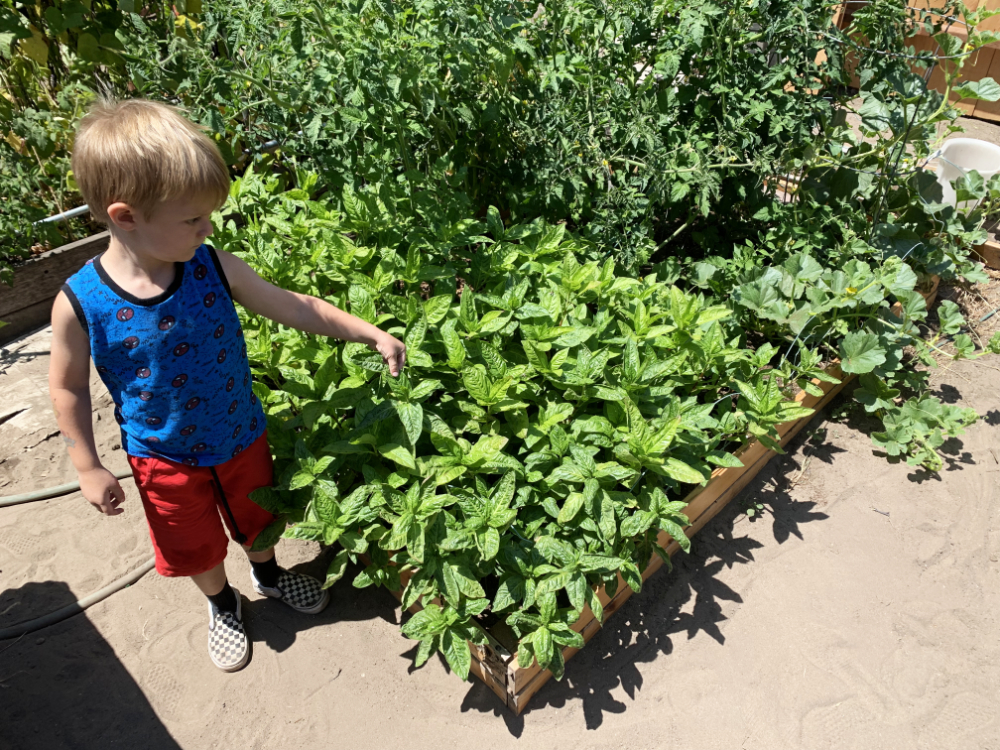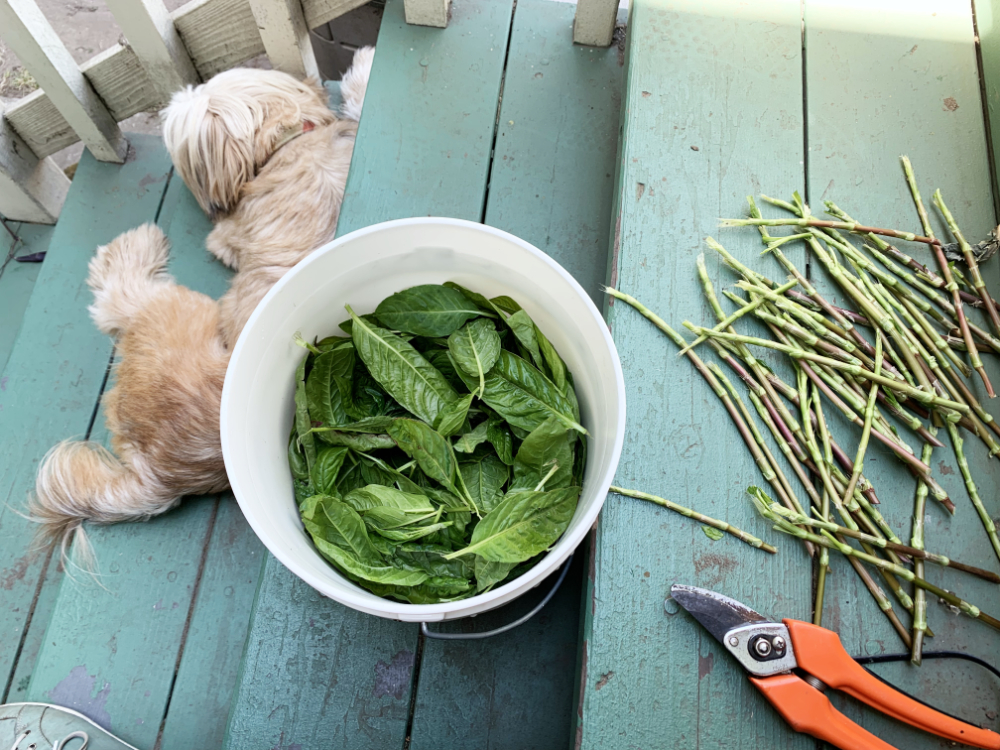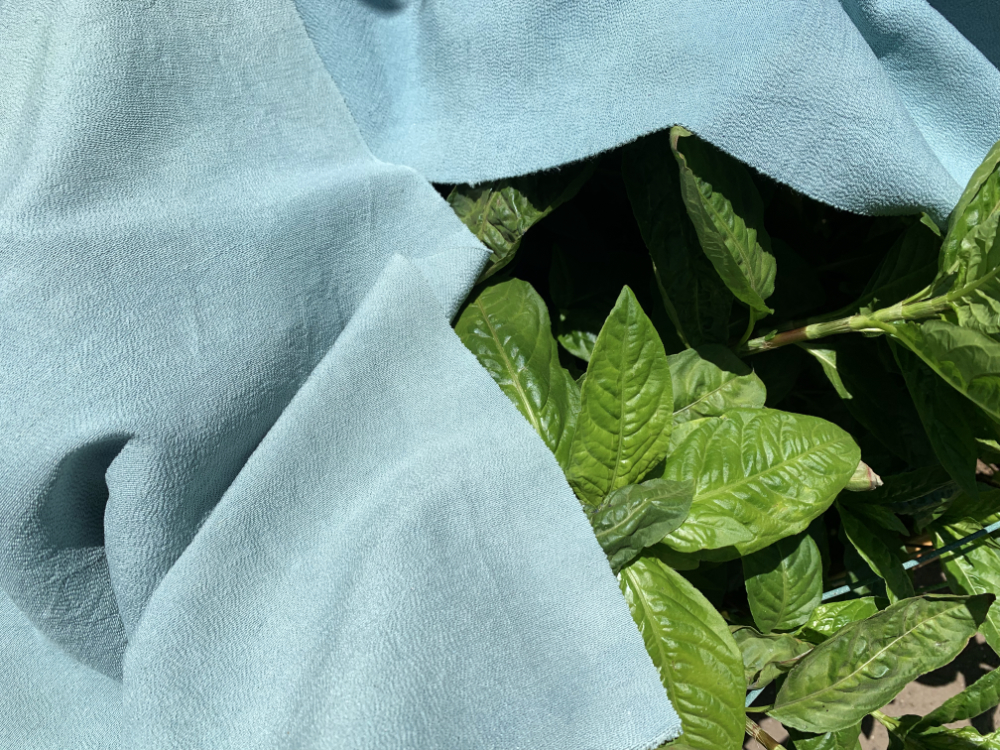The grandkids are visiting for the summer, which means I’ve been busy juggling a toddler and a bigger kid, both of whom need things to do outside.
Taking this video as inspiration, I decided to go for something we could do TODAY from start to finish and see results. [YouTube video: “Indigo Dyeing with fresh indigo leaves // 生葉で藍染”]
Our local soil is kind of garbage. It’s sandy, silty, and blows away in the wind, but we find ways to work with it.
I ordered indigo seeds from The Dogwood Dyer several months ago and lo and behold, they worked out just fine. I started them indoors in the early spring, then plonked them into a newly-prepared garden bed in our walled-in back yard garden. The walled part of it is nice in that it blocks the blustery coastal wind we have here on the San Francisco Bay. However, the walls (buildings on three sides and a fence on the fourth) are problematic in that the garden has northern exposure and only gets full sun between spring and autumn solstice. This means we can’t grow annuals back there between September and May. Our perennial camellias and geraniums do just fine.
The front yard has southern exposure and the soil bakes dry in the summer and has more problems with cats, raccoons, bugs, smokers dropping cigarettes… that sort of thing. My small test plot of indigo failed out there. The back yard turn out to be our best option.

After trimming a bucket of indigo sprigs, we still had plenty of plants left to work with. I only harvested the top parts of a few plants to see how well they grow back for a second harvest this fall. We haven’t seen rain since April and we don’t water very often, which means we don’t get a lot of lush growth (except for tomatoes, which are happy to grow with almost no water). What you can’t see is the oja (or olla) in the middle, slowly irrigating the plants in that box. I got some ojas locally at Pollinate in Oakland, CA a few years ago, and a few more directly from GrowOja.com this year.
Did I mention we also rescued a dog this summer? Yeah. He’s a handful, but he’s also a delight so that’s good.

Leaves, stems, and the dog.

We washed the leaves, added some salt, and a tossed it all in a bucket to macerate. I took two 1-yard pieces of vintage, undyed chirimen kimono silk and we went wild. We crushed, we squeezed, and we just goofed around with the leaves for a while. After each “dip” we let the fabric dry for a while, then did it again. The color was a bright turquoise-green while wet, and dried down to a soft aqua.

We have a lot of our indigo crop remaining, and we will continue to experiment and see what works with our climate, attention span, and abilities. My husband would like to do a stronger vat, which means properly fermenting the leaves and I just don’t know if I’m up for that this year.
We will definitely let some of the plants go to seed so we have more for next year. They did quite well in that bed, but struggled in another one nearby as they were crowded out by other crops (tomatoes and beans). I will also look into cover crops for the winter and companion crops for next summer.
Do you grow your own indigo? What have you experienced?
Hi – Loved your story. Looks like you will have a great dyer in the family in a few years. Liked the color on both pieces.
We are doing fine here. Just had huge monsoom storm winds and tons of rain. Hope it helps the fires.
Still planning tours but nothing leaving yet. Maybe 2022.
Judy
That is so cool! I didn’t know you could do what you did, I thought it was always a fermented activity. By the way, do you know of David Blume, Alcohol Can Be A Gas? He and his dad fed their family from an organic garden on a small lot in San Francisco. It sounds like a lot of work is involved to make decent soil there.
What a fun project to do with your grands! And the results are not only beautiful, but must be very rewarding. I’d like to try something like that, but we don’t have a suitable space to plant the indigo. I’ll just have to watch your progress. Enjoy.
I’m growing indigo, but the other kind, indigofera tinctoria, in pot inside over our NZ winter. It’s grown to about 5-6 feet tall but we’re having whitefly issues. Once it’s hotter they might go outside for summer.